The Ford Coyote is a 5.0L V8 engine powering the 2011-2020 Ford Mustang GT and Ford F-150 pickup trucks.
Since the Coyote engine’s inception, Ford has made several upgrades and changes to the platform. The most substantial changes took place with the Gen 3 version in 2018, with the introduction of a new dual fuel system comprised of direct-port and port fuel injection.
Coyote 5.0L engines are broken down into three generations. In each generation, there is a Ford Mustang version and a Ford F-150 version of the engine, with only basic differences between them.
The Coyote truck engine is optimized for torque while the Coyote Mustang engine makes more horsepower overall.
- Gen 1 Coyote 5.0L engine – 2011-14 Mustang; 2011-14 F-150
- Gen 2 Coyote 5.0L engine – 2015-17 Mustang; 2015-17 F-150
- Gen 3 Coyote 5.0L engine – 2018-20 Mustang; 2018-20 F-150
…
Each new Coyote generation brought improvements in horsepower, torque, and even rpm capability.
Gen 1 Coyote 5.0L Mustang
- 2011-12 GT – 412 hp @ 6,500 rpm – 390 ft.-lbs. torque @ 4,250
- 2013-14 GT – 420 hp @ 6,500 rpm – 390 ft.-lbs. torque @ 4,250
- 2012-13 Boss – 444 hp @ 7,400 rpm – 380 ft.-lbs. torque @ 4,500
Gen 2 Coyote 5.0L Mustang
- 2015-17 GT – 435 hp @ 6,500 rpm – 400 ft.-lbs. torque @ 4,250
Gen 3 Coyote 5.0L Mustang
- 2018-20 GT – 460 hp @ 7,000 rpm – 420 ft.-lbs. torque @ 4,600
- 2019-20 Bullitt – 480 hp @ 7,000 rpm – 420 ft.-lbs. torque @ 4,600
Gen 1 Coyote 5.0L F-150
- 2011-14 – 360 hp @ 5500 rpm – 380 ft.-lbs. torque @ 4250 rpm
Gen 2 Coyote 5.0L F-150
- 2015-17 – 360 hp @ 5500 rpm – 380 ft.-lbs. torque @ 4250 rpm
Gen 3 Coyote 5.0L F-150
- 2018-20 – 395 hp @ 5750 rpm – 400 ft.-lbs. torque @ 4500 rpm
…
For enthusiasts hunting social media marketplaces and ad sites, or combing salvage yards for a suitable dog for an engine swap, understanding the differences and requirements for these engines up front can prevent you from buying the wrong parts or being disappointed because you ended up with a truck engine when you thought you were getting the Mustang version.
…
The Mustang Coyote engines were equipped with stainless steel Tri-Y exhaust manifolds, performance based camshafts, higher compression ratio (11:1), and wider oil pump gears.
The catalytic converter on the 2015-20 Mustang 5.0L is part of the driver’s side exhaust manifolds, and on the passenger side, the converter bolts to the manifold with a two-bolt flange.
…
The F-150 Coyote engines came equipped with cast iron exhaust manifolds, broad-torque range camshafts for towing power, and 10.5:1 compression.
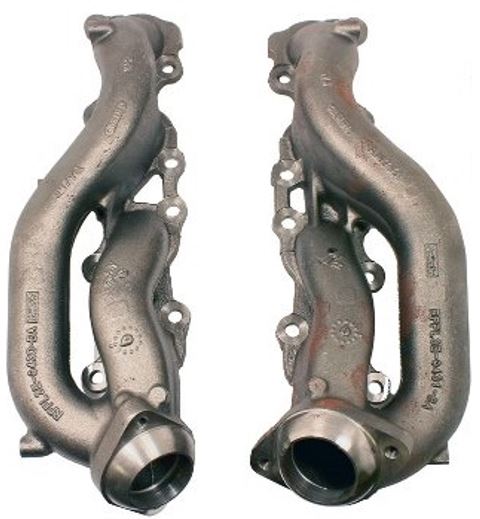
…
The Differences Between Gen 1, 2 & 3 Coyote 5.0L Engines
Here are some specific external identifying features and parts that may help you authenticate an engine at a salvage yard or from a marketplace ad.
Gen 1 Coyote engine intakes do not have charge motion control valves (CMCV) like the Gen 2 and Gen 3 engines.
CMCV are flat plates inside of the intake runners which are mounted on a single shaft (per side). Each shaft is controlled by a vacuum canister. These valves restrict airflow velocity resulting in improved idle quality and improved low-end torque on the Gen 2 and 3 engines. Under heavy throttle, the valves open to let the engine breathe freely.
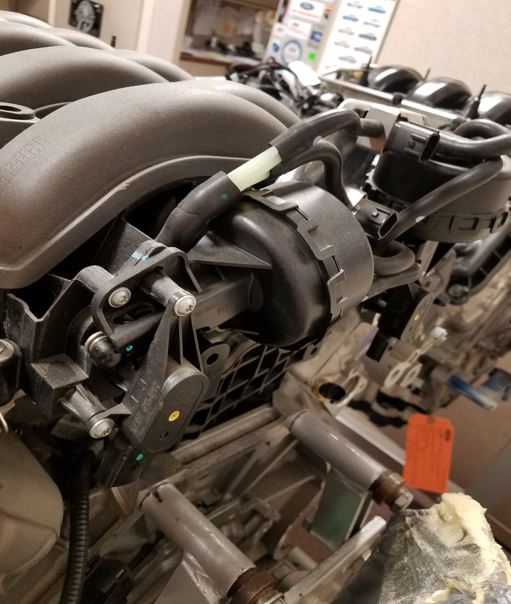
All Gen 3 engines have a direct-injection pump mounted on the passenger side of the cylinder head, which is easily identified because the #3 ignition coil is offset to clear the injection pump and uses a short ignition wire.
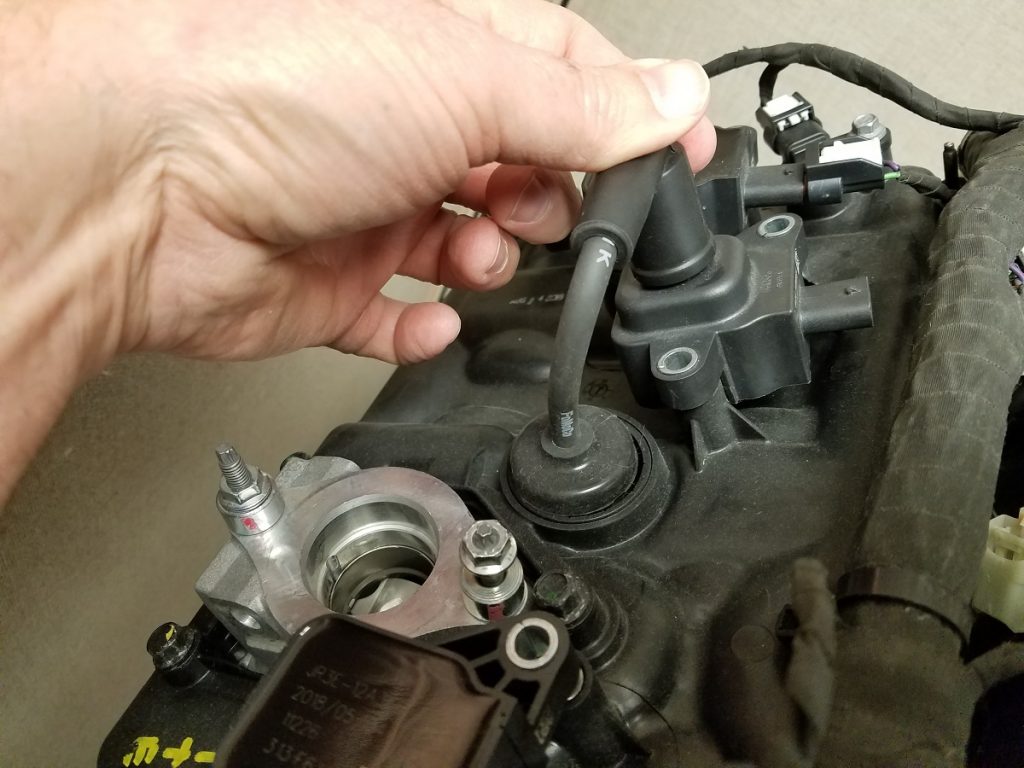
…
All Gen 1 and 2 Coyote engines have a 7-quart steel oil pan.
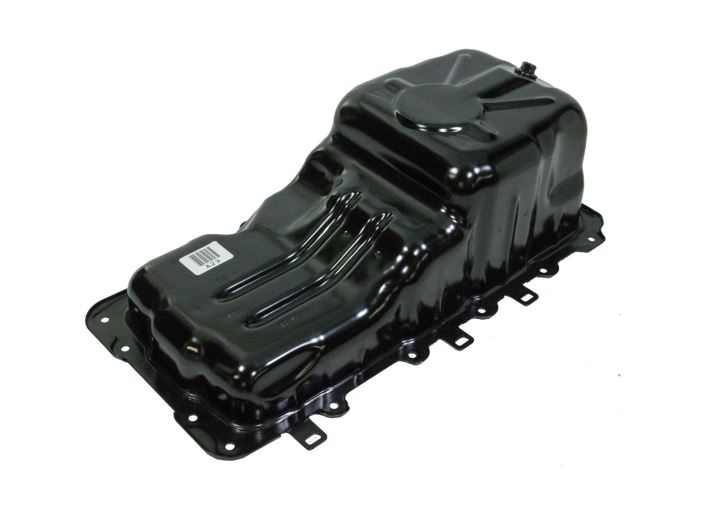
The Gen 3 engines use a larger 10-qt. composite pan.
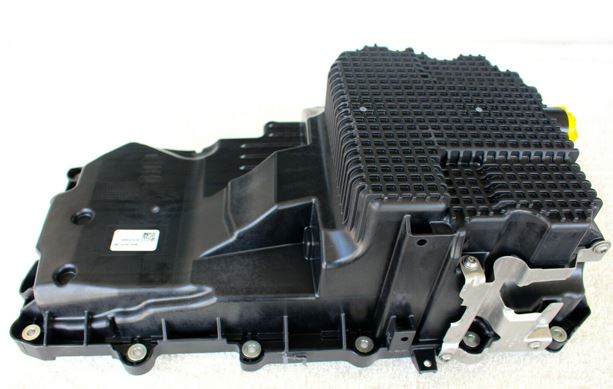
…
All three truck-engine generations had a front-mounted oil cooler/filter mount that used a 90-degree adapter to make the filter more accessible.
Gen 1 Mustang engines didn’t have an oil cooler, except for the Boss 302 and the Track Pack-optioned Mustangs.
Gen 2 and 3 Mustang engines were equipped with oil coolers mounted directly to the engine block, and didn’t use an adapter.
…
The truck and Mustang Coyote engines each used different timing covers.
The Mustang engine’s timing cover has an idler boss on the driver’s side.The F-150 engine’s timing cover moved the alternator further out to the side, and doesn’t have the idler boss.
…
The intake manifolds on the Mustang Coyote engines are gray in color. The F-150 Coyote intake manifolds are black. Note: The GT350 Mustang intake manifold is also black, but the GT350 engine is a 5.2L and this article is focused exclusively on identifying 5.0L Coyote engines.
Also, on the F-150 engines, the Gen 3 intake is taller than the Gen 2 intake.
…
We hope this information helps take some of the bite out of your hunt for the right Coyote and engine parts for your project.

So the question is. Whats the Economy read low $ approach in parts swapping to achieve a[ 1 ]track day motor swap weapon.[2] Low RPM torquer.[3] Ultra cheep good runner.? Thanks & BEST of LUCK.
Is a letter or number in the vin number on f-150 with coyote 5.0?
If so text it to me 704-300-8622
I came across a 2011 coyote truck engine that I wanted to put in my 1999 mustang GT Convertible . Is it possible to convert the F150 coyote to the mustang coyote? Are all the bolt patterns the same? With a rebuild kit will I be able to use the 11 to 1 compression pistons in the truck coyote? Will it be any valve clearance issues? Thank you.
Honestly the internals should be the same between the f150 and mustang variants. It’s just a matter of tuning the ECU if you want power over torque, that’s the biggest factor
I am trying to identify coyote block what numbers on the block can I use to make an ID truck car year
Hi David I have bought a second hand coyote crate motor it does have some numbers where the original motors have the id number ia there a way to identify from thes numbered
Dear Sir
I have a Mustang 2011 BOSS 302 engine (444 Hp) and I want to buy crank shaft of the F150 2012 and install it in my engine, shall it fit ?? or they have different crank shafts.
Thanks
Tarek Fathey
Why would you even consider that? That is a horrible idea. There is a big difference in the boss internals and the truck.
Hi just wanted to inform you the gen 2 F150 5.0 makes 385 hp at 5750 rpm and 387 lb at 3850 rpm if I remember correctly.
You are correct. I bought mine new and that’s what the documentation says.
Dave I purchased a low mileage 2017 coyote mustang engine that came with six sp, manual Trany but since I am installing the engine in my pro-street model A Ford the six sp.stick shift doesn’t seem to be the hot setup. So I purchased a six sp. auto trany. But the trans came out of a truck. Will this work out ok. From Ford motor sports I purchased there plug and play wiring kit for the auto trans.and I will be using a 4.30 nine inch.with 29:5 dia. 10” wide rear tires I want to use the first 4 speeds to reach the time trades at estimated speed about 140 MPH and 9:90 ET. Should I install a perf. Stall converter?
C’mon Cyril,
Don’t give up on the stick. So it’s a little slower. At least you are driving something your grandma can’t!
lol hate to tell you this but your grandmothers used to drive manual transmissions it’s your young generation today that can’t drive a stick lol
I have a 1988Lincoln town 5.0 will a coyote fit in it
Usually anything 1987-1993 a coyote will fit …mustang or LSC’s….Lincoln’s set up that year 1988 is the same as the mustangs…the coyote should fit with just mounting adjustments.
How do I tell if I have a 5L coyote motor by the vin# ?
In A 2014 F150
I really enjoyed this article and the type of information it provided. I would like to know more about the 5.0 such as the type writer tic what causes the oil pump to break under stress. What can I do to a gen 1, 5.0 to bring it close to the mustang hp output. Are cams the only way.thank for listening.
Will a coyote engine fit in a 1982 F150?
Hey JD, I was genuinely curious about this myself, so I did some internet sleuthing and found a forum post where a guy documents his 1982 F-150/Coyote swap. So yeah, it’s definitely doable. Click here to read the thread. Good luck!
Dave,
I’m installing a Gen 3 5.0L Mustang engine in a 1950 Ford F-3 restoration. Where can I find aftermarket Plenum and Cam Covers to dress up the engine? Thanks for any insight.
This is really great information. I wanted to ask Mr. Matthews if he recommends the 5.0 liter and especially for a used F-150 2015-2017 ? I’ve had both GM’s and Fords, but the ‘04 F-150 with a 5.4 was a disaster engine with spark plugs seizing in the block. GM’s are great motors (4.8 & 5.3) but I find that other components are less reliable. Thanks !!
Is there a stamping on Coyote that tells which one it is?
I saw one listed as a Ford 5.0 E152108006131138.
Love the great attention I always get at Summit BTW
With the mustang and f150 3rd generation being the same, why does the mustang use 10 qt of oil and the f150 use 8.8 qt ????
I have a 2018 f150 with the 5.0. The oil pan is the 10 qt. There is TSB for a reflash and dip stick change to account for the wrong oil capacity info. When I do the oil change it take 10 qts to hit the full mark on the stick
Dave, Is the Gen2 F150 5.0L ticking/rattle actually piston slap or injector operation? 2017 F150 39K. Is there anything that can be done to mitigate the engine noise? Thanks.
Aloha, Dave… I have a 2020 F-150 5.0L V8. Are all 5.0L V8s Coyote engines? If not, how can I determine things? Please advise. Mahalo, Dave…
Hey Miles. All modern 5.0Ls (2011+) are Coyotes. They’re based on Ford’s “Modular” engine family that originally appeared as a 4.6L back as the 1990s. Previous Ford 5.0L engines were based off the venerable 302 cubic inch Windsor block and share little similarity with the new 5.0L based off that Modular platform.
…
So yeah, the 5.0L in your F-150 is a Coyote. But it comes in a slightly different tune than, say, a Mustang.
I have a 92 f150 flareside with a5.0 been wondering cani fit a cobra tranny and will it help run better and faster?
Yes it will work! I’ve done the same thing on my 93 ford f150.
I have a 1959 t-bird I want to put a 2015 coyote from the mustang in it would like to know if it’s doable
Will the gen 1 and gen 2 swap out on a 2012 f150
why can’t i find a replace camshaft bearing cap 1-2 for 2011 5.0l coyote engine. if anyone could help that would be great. i dont want to buy a head when i only need a $30.00 cap.
Hey Marcus, I did a brief bit of research and, from what I can tell, Ford doesn’t sell them separately because they’re matched to the head and specific location along the cam–which may mean that any replacement cap you’ll find might need to be honed. Just a quick internet search revealed a few places that sell OEM takeoffs, but you might just have better luck going to your local scrapyard, yanking one (or a few) and taking them to a machine shop. Hope this helps.
Got to love them Fords my first vehicle was a 1970 Ford Maverick all original 250 straight 6 three speed on the tree and 50 mph with the windows down LOL LOL LOL no power steering no power brakes no power windows no power nothing so it was a workout especially when the engine blew up turning my transmission into three different parts and blowing a 6-in hole out the side of that 250 straight 6 I parked at the next morning put it on jack stands started taking it apart work for 6 months taking a bus back and forth to work,saved up money every check and then started buying my parts engine transmission shocks brakes suspension parts Chrome kit you name it headers my headman headers motor mounts trunk paint was painted in it underneath the engine compartment really nice all I needed was a new hood or fix the front where the Ford emblem going to cross and had rest in the bottom of the hood and I had the six-cylinder rear end and it still which was churning the pipes inside the pumpkin which obviously was leaking juice from there LOL LOL and then I just turned 5,000 mi cuz I had reset my odometer cuz it was a new motor pretty much a brand new car we did the entire interior myself all black indoor outdoor carpet really nice bucket seats the only thing on the interior needed was a new headliner it was just a stitching that was broken but other than that it was immaculate no AC no power nothing 55 and windows down LOL LOL so at 5,000 miles taking my soon to be wife home from a job interview the day that I skipped out of work getting off the interstate doing around 40 mph which was under the speed limit a F-250 four-door 4×4 long bed pulled right out in front of me totaled my car that I worked on and spent a lot of money to me back then my first car and then I bought a truck and I’ve had trucks ever since of course all Fords right now my Ford van blew up cuz I’m an electrician and I work for myself I’m partially disabled so I cannot work full time on a job up and down a ladder like I used to a little bit over 10 years ago I work for myself for the past 12 years and I could do pretty much anything any of my customers needed but now I can’t even get to my customers but my last new truck was a 2012 triple black with the metal rainbow flakes four-door short van with a coyote motor in it I did headers cold intake exhaust little tweaks here and there I don’t like to have same vehicles as anybody else every vehicle I’ve ever owned I’ve always had to put my touch to it and make it different and I always wanted a truck I was a proud owner of four lightning’s 3 gen 1 and 1 Gen 2 and believe it or not I bought back the Gen 2 for the place I bought my 2005 f250 long bed four-door from it had the 5.4 in the truck so I missed my other truck the Gen 2 lightning which I had it a lot of work done to all of them but that one had the supercharger I did the four valve heads HPC ceramic coated headers complete upper intake replacement upgrade larger throttle body and the little trick I found on the internet to have the supercharger always boost ready so every time you press the pedal it was always on what a ride LOL LOL but hopefully God will let me get another truck and another coyote motor so I can get back and forth to work and get to see my children my ex-wife has the two youngest ones at home with her still it was a mutual divorce but I gave her everything because I don’t take anything from somebody I divorced her for the things she did and of course I wasn’t perfect but we had been together since 8th grade and now I suffer all alone and I have no vehicle to get around we had a total of five children same wife same mother my son is the oldest and four daughters I can’t even go to see any of them or to visit them at work like I always wished I could have my brothers or my father come and visit me but I didn’t know my father so I know what they feel like and it would be great to see their dad at work sorry for the SOB story, I have been a Ford man before I even bought my 1970 Ford Maverick which on the plate said it was made and built on December 1970 which I was born on the 8th of 1970 of December what a coincidence my first vehicle I paid for built it then totaled it my brother was the one that convinced me to always have a truck cuz you can use it for work and make money and that’s what I’ve been doing for over 30 years since I bought my first truck after totaling my first car but owning the four lightnings was one of the best things I ever had God I wished I would have never got rid of any of them but I had a family to take care of and they come first and then a divorce and then the foreclosure??!? Yada yada yada LOL LOL LOL thanks for letting me leave a comment I love Ford I name my son Alec Ford so you can know that I’m in the Fords all the way around and Chevys long as you take care of a vehicle it’ll take care of you thank you all God bless, Ford keep up with the good work if I have a choice to get another truck I’m going to go with the Godzilla I think it’s a 7.3 L and then throw a three or four liter supercharger on top hopefully be one of the first people to have a 10 or 11 liters engine purely horsepower sincerely a four guy Bobby Lee Torres
It’s Bobby again I wanted to apologize for all the misspelled and quirky sentences I’m doing this via voice on my cell phone I wanted to reiterate on the 1970 Maverick I installed a 302 with a cam and some head work high-rise intake a Holley 750 double pumper the headman headers and a c 4 transmission that I rebuilt by myself with a shift kit with no experience whatsoever working on motors other than with my brother-in-law here and there that was a really fast and nice car for being a 1970 I had pictures of it but somehow they got lost I wish to God I still had them it was a beautiful motor a complete Ford prom kit you name it it was Chrome back then that was the flashy thing this was 1986, I also put a Hurst ratchet shifter on the floor got rid of the three speed column put an automatic column on there brand new dash bucket black seats all black black interior new black panels all the metal in the inside was painted black indoor outdoor carpet on the entire floor bucket seats out of a 77 Ford cougar the c4 transmission how to do some finagling to get that bad boy in there like I said a trick cam hydraulic lifters electric fans a radiator out of a 82 f150 had to make a few modifications to get it fit but it worked at the engine perfect temperature a nice meter tachometer my speedometer worked everything worked in the vehicle put a new stereo in it from my brother’s custom truck he drove had a nice stereo system in it he gave it to me before he sold it and bought him a brand new 1987 f250 with a Cummins diesel or whatever diesel motors it was back then the 7.0 6.5 7.3 I don’t remember it wasn’t my truck but anyways everything you can imagine that could be done I did but I did need to replace that 263 rear end from the six cylinder 3 speed but it was strong and held in when I turn the 5000 mi and I hit that truck I sold it for parts hated to see it go and like I told her earlier I bought me a 1984 F100 ranger regular cab long bed no power windows locks but I had AC a stereo power steering power brakes and it had the straight six 300 automatic c4 transmission so it was strong back then it didn’t have much horsepower I think it was like 180 horsepower and like 220 lb of torque maybe a little bit more cuz it was a truck and the six cylinders are good motors if I ever had to change motors or put a motor in any vehicle it would be the straight 6 300 done up of course with a turbo pushing around 500 horsepower 500 lb of torque or a new coyote 302 headers and all that good stuff and a five-speed transmission maybe a 6-speed that way I can get rid of some of the electronics but you still have to have the basics for the fuel injection system in the computer box plug and Play LOL thanks again you guys sincerely Bobby T
It’s Bobby again I wanted to apologize for all the misspelled and quirky sentences I’m doing this via voice on my cell phone I wanted to reiterate on the 1970 Maverick I installed a 302 with a cam and some head work high-rise intake a Holley 750 double pumper the headman headers and a c 4 transmission that I rebuilt by myself with a shift kit with no experience whatsoever working on motors other than with my brother-in-law here and there that was a really fast and nice car for being a 1970 I had pictures of it but somehow they got lost I wish to God I still had them it was a beautiful motor a complete Ford prom kit you name it it was Chrome back then that was the flashy thing this was 1986, I also put a Hurst ratchet shifter on the floor got rid of the three speed column put an automatic column on there brand new dash bucket black seats all black black interior new black panels all the metal in the inside was painted black indoor outdoor carpet on the entire floor bucket seats out of a 77 Ford cougar the c4 transmission how to do some finagling to get that bad boy in there like I said a trick cam hydraulic lifters electric fans a radiator out of a 82 f150 had to make a few modifications to get it fit but it worked at the engine perfect temperature a nice meter tachometer my speedometer worked everything worked in the vehicle put a new stereo in it from my brother’s custom truck he drove had a nice stereo system in it he gave it to me before he sold it and bought him a brand new 1987 f250 with a Cummins diesel or whatever diesel motors it was back then the 7.0 6.5 7.3 I don’t remember it wasn’t my truck but anyways everything you can imagine that could be done I did but I did need to replace that 263 rear end from the six cylinder 3 speed but it was strong and held in when I turn the 5000 mi and I hit that truck I sold it for parts hated to see it go and like I told her earlier I bought me a 1984 F100 ranger regular cab long bed no power windows locks but I had AC a stereo power steering power brakes and it had the straight six 300 automatic c4 transmission so it was strong back then it didn’t have much horsepower I think it was like 180 horsepower and like 220 lb of torque maybe a little bit more cuz it was a truck and the six cylinders are good motors if I ever had to change motors or put a motor in any vehicle it would be the straight 6 300 done up of course with a turbo pushing around 500 horsepower 500 lb of torque or a new coyote 302 headers and all that good stuff and a five-speed transmission maybe a 6-speed that way I can get rid of some of the electronics but you still have to have the basics for the fuel injection system in the computer box plug and Play LOL, oh and I screwed up about my Gen 2 lightning I did not put four valve heads on there because I would had to change the entire block cuz everybody knows four valves or quad overhead cams I did do heads but not for valve some trick flow ported and polished but I did do the in the upper intake and the throttle body and all the little chicks I could do to the engine under dry pulleys headers hbc-coated like I did my other lightnings from bassini they’re a great company I had the inch and 7/8 equal length Shorty’s ceramic coated very nice I love that color of brushed aluminum polished aluminum looks better than any Chrome didn’t have much Chrome on there did a little bit of work on the Outside inside was completely immaculate and still brand new but God I wished I could get me another truck or vehicle. I’m too old to be riding bikes to the store in the rain or to go to my doctor’s appointments it’s really difficult in this world today to not have a vehicle so congratulations to everybody out there that has a Ford or a good running vehicle no matter what make model take care of it and it’ll take care of you God bless and Godspeed peace out
Hi there. After reading this article it sounds like you have in depth knowledge of the Coyote engine. Do you have any idea why many Coyote engines develope the Typewriter Tick after the first oil change? I was hoping yo buy a 2013 GT. Beautiful version of the California addition. Darn thing had the tick. So I stayed away.
Hello guys hope you guys doing great . So can I make my v6 3.8 L into a coyote?
Hi, I have a 2014 Mustang GT (Gen 1 Coyote) and have learned that some late model ’14s received Gen 2 cylinder heads. How do I find out if my motor has the Gen 1 or Gen 2 heads? Thanks in advance?
Help! Sure hope you can answer the following question: What year/model Land Rovers have the Ford coyote engine? Awaiting your reply…
Will the both the intake and exhaust cam phasers for the 2016 Gen 2 5.0 Mustang work on the 2016 Gen 2 5.0 F-150?
Will a 6.0 power stroke or an 7.3 power stroke engine bolt right up to a 92 ford f150 single cab 2wd trucks frame?? Or would I have to do some modifications? The truck has a 5.0l v8 sitting in it as of now.
I have a 15 F150 5.0 that I wanted to change to Mustang Cams for better performance. I know the cams between the Mustang and F150 are diff as your hp/tor specs show, but your cam spec sheets show the same lift and duration are the same. I think there is a disparity with this. Can someone correct me pls. On the forums they say the exhaust cams are the same but the int cams are the ones that are diff. Can someone verify this for me pls. I know this has prob been beat to death but Im new to the f150.